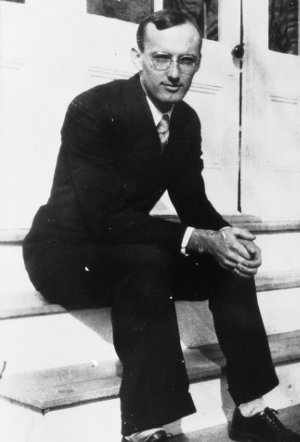 Karl Jansky on the steps of his home, 1928. Credit: NRAO/AUI/NSF
Karl Jansky on the steps of his home, 1928. Credit: NRAO/AUI/NSF
Karl Guthe Jansky
Contributed by Kenneth I. Kellermann and Ellen N. Bouton
Karl Guthe Jansky was born on October 22, 1905 in the territory of Oklahoma, and grew up in Madison Wisconsin, where his father was a Professor of Electrical Engineering at the University of Wisconsin. Later, as a student at the University of Wisconsin, Karl excelled in sports especially ice hockey, and received his BS in Physics, graduating Phi Beta Kappa in 1927. Following a year of graduate study, Karl went to work at Bell Laboratories in rural New Jersey, where he began a series of studies to improve the quality of transatlantic radio-telephone communications.
In 1929, Karl married Alice Larue Knapp, and they had two children, Ann Moreau and David. In spite of a chronic kidney ailment that would ultimately lead to his premature death, Karl led an active live. He was the table tennis champion of Monmouth County New Jersey, enjoyed skiing, bowling, chess, tennis and golf; had the highest batting average on the Bell Labs softball team, was a passionate bridge player, an avid Brooklyn Dodger fan, and a fervent critic of President Franklin Roosevelt's New Deal.
Following a series of pioneering observations made between 1930 to 1932 using his iconic rotating directional Bruce Array at 20.5 MHz (14.6 meters), Jansky wrote to his father reporting that the excess noise was "not only extraterrestrial but from outside the solar system." On April 27, 1933, 27 year old Karl Jansky presented a paper at the annual Washington meeting of the US National Committee for URSI where he reported that his "star noise" came from the center of the Milky Way Galaxy.
Although Jansky's remarkable discovery of galactic radio emission made the front page of the May 5, 1933 edition of the New York Times and other national publications, it received little attention from professional astronomers. Due to the increasing demands of defense work at Bell Labs, and the deteriorating economic conditions during the depression, Jansky had little opportunity to continue his study of "star noise." Until his death on February 14, 1950, he worked on a variety of defense activities, including the electronic detection of enemy submarines for which he received an Army-Navy citation. After the end of WWII, Jansky worked on the early development of the AT&T microwave repeater network to enhance long distance telephone communication, becoming one of the first to use the newly developed transistor to build low noise amplifiers. He received patents on a radio direction-finder using the radio emission from the Sun, which was later developed by the Collins Radio Company.
Karl was nominated for the 1948 Nobel Prize in Physics, but this was before the importance of radio astronomy was widely appreciated. Following a series of strokes, Karl Jansky died on February 14, 1950 at the young age of 44, the year before the discovery of the 21 cm hydrogen line brought radio astronomy to the attention of the broad astronomical community. However, Jansky's name was immortalized in 1973, when the IAU resolved that "the name 'Jansky' abbreviated 'Jy' be adopted as the unit of flux density." Later, after a major upgrade, the NRAO Very Large Array was rededicated as the "Karl G. Jansky Very Large Array."
![[IAU logo]](iau_wb_thumb.jpg)
![[URSI logo]](URSI-logo-thumb.jpg)
![[Karl Jansky at his antenna]](jansky_photo_02_thumb.jpg)
![[Reber's Wheaton antenna]](Reber_Telescope_Wheaton_thumb.jpg)
![[Dover Heights]](Dover_Heights_02_thumb.jpg)
![[4C telescope]](GB61-195_4C_telescope_thumb.jpg)
![[Ewen and horn antenna]](ewen_horn1s.jpg)
![[Dwingeloo, 1956]](Dwingeloo-1956-thumb.jpg)
![[Jocelyn Bell Burnell and Cambridge antenna used in pulsar discovery]](burnell2_thumb.jpg)
![[Lovell Telescope at Jodrell Bank]](site_1594_0001-500-334-20180316163019-thumb150.jpg)
![[Wilson, Penzias, and Bell Labs horn antenna]](wilson-penzias-horn_thumb.jpg)
![[6-m Millimeter Radio Telescope in Mitaka, Japan]](6m-thumb.jpg)

